A United Launch Alliance Altas V 401 rocket like that shown here will launch the next Orbital Sciences Cygnus cargo ship to the space station in place of the Antares rocket. NASA’s Mars-bound MAVEN spacecraft launches atop Atlas V booster at 1:28 p.m. EST from Space Launch Complex 41 at Cape Canaveral Air Force Station on Nov. 18, 2013. Image taken from the roof of the Vehicle Assembly Building (VAB) at NASA’s Kennedy Space Center. Credit: Ken Kremer/kenkremer.com
More photos added[/caption]
Following the catastrophic Oct. 28 failure of an Orbital Sciences Corporation Antares rocket on a critical resupply mission to the space station for NASA, the company is seeking to quickly make up the loss to NASA by announcing the selection of the venerable Atlas V rocket built by United Launch Alliance to launch Orbital’s next Cygnus cargo ship to the orbital science lab.
Orbital and ULA signed a contract to launch at least one, and up to two, Cygnus cargo missions to the International Space Station (ISS) under NASA’s Commercial Resupply Services (CRS) program.
The first Cygnus mission would liftoff sometime late in the fourth quarter of 2015 aboard an Atlas V 401 vehicle from Space Launch Complex 41 (SLC-41) at Cape Canaveral Air Force Station in Florida.
Given that ULA’s full launch manifest was fairly full for the next 18 months, Orbital is fortunate to have arranged one or two available launch slots so quickly in the wake of the Antares launch disaster.
“Orbital is pleased to partner with ULA for these important cargo missions to the International Space Station,” said Frank Culbertson, Orbital executive vice president and general manager of its Advanced Programs Group.
“ULA’s ability to integrate and launch missions on relatively short notice demonstrates ULA’s manifest flexibility and responsiveness to customer launch needs.”
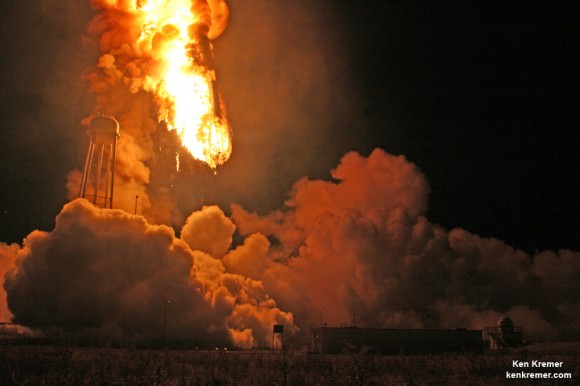
Orbital also stated that there will be “no cost increase to the space agency” by utilizing the Atlas V as an interim launcher.
If necessary, a second Cygnus would be launched by the Atlas V in 2016.
The 401 version of the Atlas uses a 4 meter diameter payload fairing, no solid rocket boosters strapped on to the first stage, and a single-engine Centaur upper stage.

Orbital had been evaluating at least three different potential launch providers.
Observers speculated that in addition to ULA, the other possibilities included a SpaceX Falcon 9 or a rocket from the European Space Agency at the Guiana Space Center.
“We could not be more honored that Orbital selected ULA to launch its Cygnus spacecraft,” said Jim Sponnick, vice president, Atlas and Delta Programs.
“This mission was awarded in a highly competitive environment, and we look forward to continuing ULA’s long history of providing reliable, cost-effective launch services for customers.”
The Orbital-3, or Orb-3, mission that ended in disaster on Oct. 28 was to be the third of eight cargo resupply missions to the ISS through 2016 under the NASA Commercial Resupply Services (CRS) contract award valued at $1.9 Billion.
The highly anticipated launch of the Antares rocket on Oct 28 suddenly went awry when one of the Soviet-era first stage engines unexpectedly exploded and cascaded into a spectacular aerial fireball just above the launch pad at NASA’s Wallops Flight Facility on the Orb-3 mission to the ISS.
Read my earlier eyewitness accounts at Universe Today.
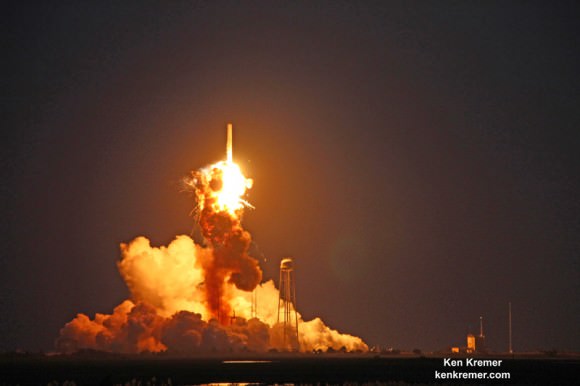
Orbital was awarded a $1.9 Billion contract with NASA under the CRS program to deliver 20,000 kilograms of research experiments, crew provisions, spare parts, and hardware for the eight ISS flights.
In choosing the Atlas V with a greater lift capacity compared to Antares, Orbital will also be able to significantly increase the cargo mass loaded inside the Cygnus by about 35%.
This may allow Orbital to meet its overall space station payload obligation to NASA in 7 total flights vs. the originally planned 8.
The venerable Atlas V rocket is one of the most reliable and well built rockets in the world.
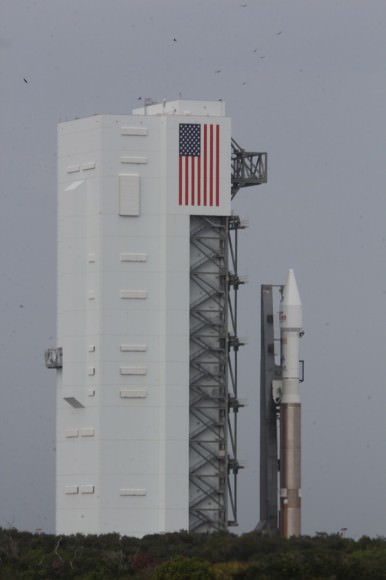
Indeed the Atlas V has been entrusted to launch many high value missions for NASA and the Defense Department – such as MAVEN, Curiosity, JUNO, TDRSS, and the X-37 B.
MAVEN launched on a similar 401 configuration being planned for Cygnus.
The two-stage Atlas rocket is also being man-rated right now to launch humans to low Earth orbit in the near future.
Orbital is still in the process of deciding on a new first stage propulsion system for Antares’ return to flight planned for perhaps sometime in 2016.
Watch here for Ken’s ongoing reporting about Antares and NASA Wallops.
Stay tuned here for Ken’s continuing Earth and Planetary science and human spaceflight news.
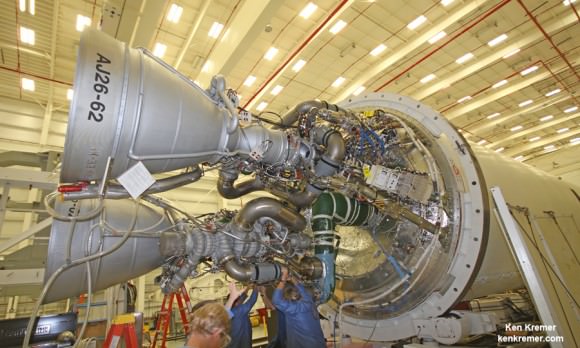

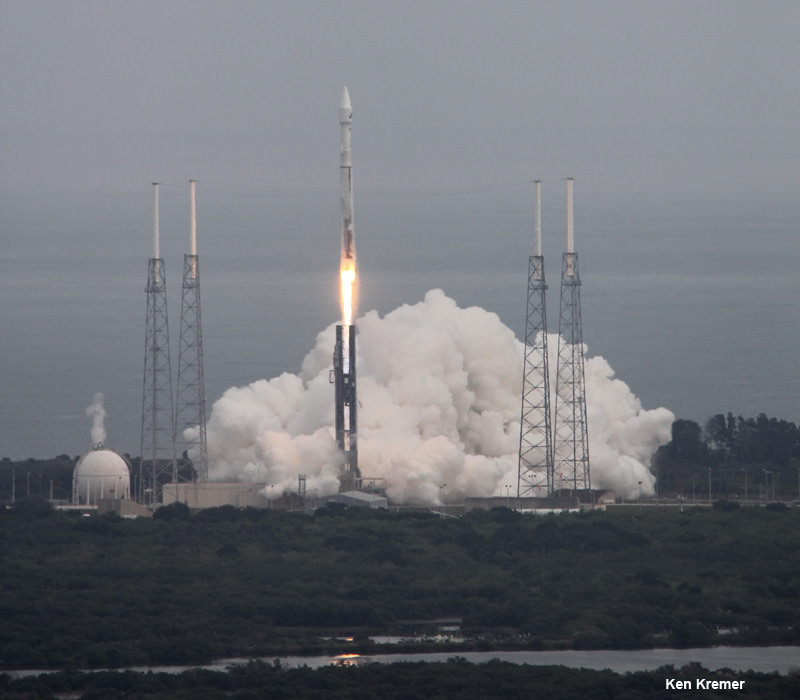
There is a bit of a problem with Atlas V regarding RD-180 engines, which are made in Russia.
Those will be probably replaced by BE-4 engines made by Blue Origin.
http://www.ulalaunch.com/ula-and-blue-origin-announce-partnership.aspx
I’ve been following the BE-4 a little and it seems it can’t be a direct replacement for the RD-180 in the following sense….
The BE-4 will burn Methane, which is good in that Methane is about 3% more energy dense than Kerosene, But the drawback with Methane is that it mixes with LOX at about 1 part to 3, whereas Kerosene mixes with LOX at about 1 part to 2
An Atlas V burning Methane would need to carry about 20% more LOX for an equivalent mission compared to an Atlas V burning Kerosene.
That’s a lot more weight at lift-off, so the engines with have to be more powerful and the booster stage will need to be stronger. It will also have a higher CoG due to the extra LOX.
It seems as though introducing the BE-4 will entail introducing the Atlas VI or at least a VERY heavily modified Atlas V.
But ….. I been wrong before 🙂
We are probably both wrong as we try to use logic. Those who are deciding will use money, but there are already doubts :
http://spacenews.com/compromise-appropriations-bill-includes-220-million-for-new-rocket-engine/
Hmmm. I got this very very wrong.
There’s no way the Atlas V is less expensive than the Falcon 9 as an option for Orbital. So it must have been the case that the Falcon 9 was NOT an option. Perhaps SpaceX is fully booked with no spare LV’s to offer their CRS competitor for next year.